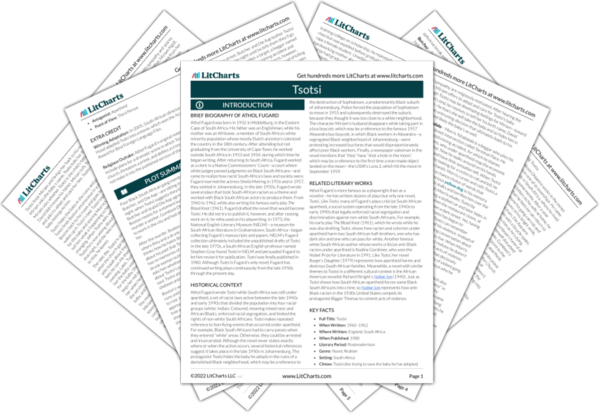Township Quotes in Tsotsi
[Tsotsi’s] knowledge was without any edge of enjoyment. It was simply the way it should be, feeling in this the way other men feel when they see the sun in the morning. The big men, the brave ones, stood down because of him, the fear was of him, the hate was for him. It was all there because of him. He knew he was. He knew he was there, at that moment, leading the others to take one on the trains.
Tsotsi knew one thing very definitely now. Starting last night, and maybe even before that, because sitting there with a quiet mind to the events of the past hours it seemed almost as if there might have been a beginning before the bluegum trees, but regardless of where or when, he had started doing things that did not fit into the pattern of his life. There was no doubt about this. The pattern was too simple, too clear, woven as it had been by his own hands, using his knife like a shuttle to carry the red thread of death and interlace it with others stained in equally sombre hues. The baby did not belong and certainly none of the actions that had been forced on him as a result of its presence, like buying baby milk, or feeding it or cleaning it or hiding it with more cunning and secrecy than other people hid what they had from him.
Gumboot had been allocated a plot near the centre. He was buried by the Reverend Henry Ransome of the Church of Christ the Redeemer in the township. The minister went through the ritual with uncertainty. He was disturbed, and he knew it and that made it worse. If only he had known the name of the man he was burying. This man, O Lord! What man? This one, fashioned in your likeness.
What is sympathy? If you had asked Tsotsi this, telling him that it was his new experience, he would have answered: like light, meaning that it revealed. Pressed further, he might have thought of darkness and lighting a candle, and holding it up to find Morris Tshabalala within the halo of its radiance. He was seeing him for the first time, in a way that he hadn’t seen him before, or with a second sort of sight, or maybe just more clearly. […]
But that wasn’t all. The same light fell on the baby, and somehow on Boston too, and wasn’t that the last face of Gumboot Dhlamini there, almost where the light ended and things weren’t so clear anymore. And beyond that still, what? A sense of space, of an infinity stretching away so vast that the whole world, the crooked trees, the township streets, the crowded, wheezing rooms, might have been waiting there for a brighter, intense revelation.
It was a new day and what he had thought out last night was still there, inside him. Only one thing was important to him now. ‘Come back,’ the woman had said. ‘Come back, Tsotsi.’
I must correct her, he thought. ‘My name is David Madondo.’
He said it aloud in the almost empty street, and laughed. The man delivering milk heard him, and looking up said, ‘Peace my brother.’
‘Peace be with you’, David Madondo replied and carried on his way.
The slum clearance had entered a second and decisive stage. The white township had grown impatient. The ruins, they said, were being built up again and as many were still coming in as they carried off in lorries to the new locations or in vans to the jails. So they had sent in the bulldozers to raze the buildings completely to the ground.
They unearthed him minutes later. All agreed that his smile was beautiful, and strange for a tsotsi, and that when he lay there on his back in the sun, before someone had fetched a blanket, they agreed that it was hard to believe what the back of his head looked like when you saw the smile.












